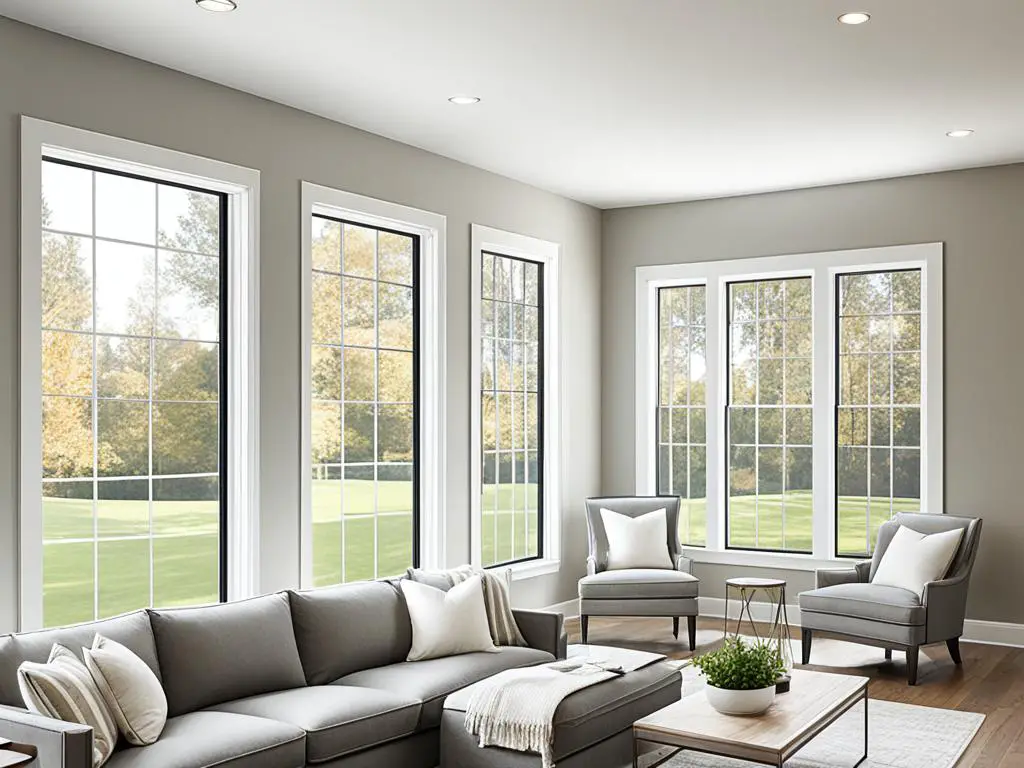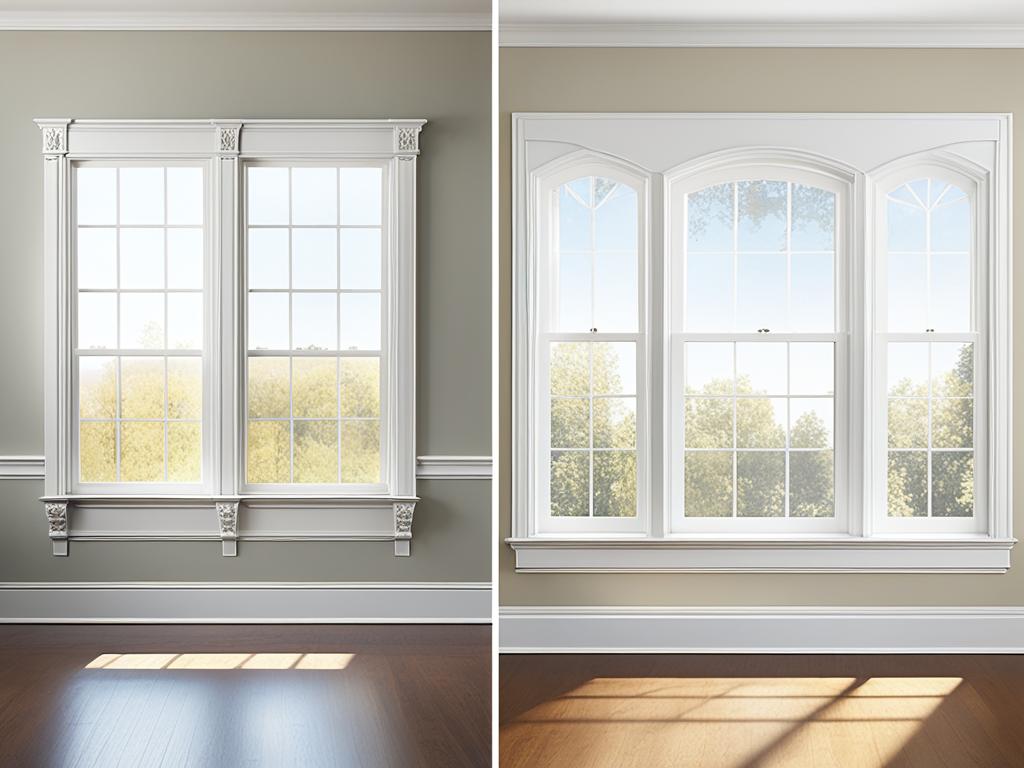Window treatments have long been a staple in home design, but the debate between window trim vs no trim is a stylish one. Many people believe that window treatments are necessary for privacy and to add softness to a space. However, there is a growing movement towards undressed windows, especially in modern homes, where the clean lines and uncluttered look are highly appreciated. Whether you choose window trim or no trim, it ultimately depends on your personal style and the overall aesthetic of your home.
Key Takeaways:
- Window trim and no trim are both valid design choices for windows.
- Window trim can enhance the overall design of a room and add architectural interest.
- No trim offers a minimalist and clean look that allows for maximum natural light.
- Your decision should be based on your personal style and the overall aesthetic of your home.
- Consider exploring design inspiration to help you make the right choice.
The Benefits of Window Trim
Window trim is a versatile design element that offers numerous benefits for your home. Not only does it enhance the look of your windows, but it also contributes to the overall design aesthetic of the room. Whether you’re aiming for a traditional or modern style, window trim can elevate the architectural interest and create a visually appealing space.
Enhancing the Look of Windows
Window trim plays a crucial role in framing your windows and drawing attention to their beauty. It adds definition and depth, making the windows stand out as focal points in the room. By choosing the right window trim style, you can highlight the unique features of your windows and create a visually stunning effect.

Adding Architectural Interest
Window trim is not only aesthetically pleasing but also contributes to the architectural interest of the room. It brings character and charm to an otherwise plain and ordinary space. With window trim, you can create a sense of grandeur and elegance, making the room feel more inviting and sophisticated.
Making Ceilings Feel Taller
One of the remarkable advantages of window trim is its ability to make ceilings appear taller. By adding trim to the top of your windows, you can visually extend the height of the room. This illusion of height creates a more spacious and open atmosphere, enhancing the overall design and making the room feel more grand.
Window Trim Styles and Designs
When it comes to window trim, there is a wide range of styles and designs to choose from. You can opt for traditional trim profiles that exude elegance and timeless beauty or go for modern and sleek designs that offer a minimalist appeal. From simple flat stock trim to intricate jamb extensions and reveals, there’s a window trim style to suit every taste and home aesthetic.
| Traditional Window Trim | Modern Window Trim |
|---|---|
| Classic profiles with ornate details | Clean lines and minimal embellishments |
| Timeless elegance | Sleek and contemporary |
| Enhances traditional and vintage interiors | Perfect for modern and minimalist spaces |
Installation Made Easy
Installing window trim is a relatively simple process that can be done by homeowners with basic DIY skills. With the right tools and materials, you can transform your windows and give them a refined and polished look. There are plenty of online tutorials and resources available to guide you through each step of the installation process, making it accessible and achievable for all.
By incorporating window trim into your home design, you can enhance the beauty of your windows, add architectural interest, and create a visually pleasing space. With the variety of window trim styles and the ease of installation, it’s a worthwhile investment that can significantly elevate the aesthetic appeal of your home.
The Appeal of No Trim
No trim around windows is gaining popularity, especially in minimalist and modern homes. With no trim, the focus is on the window itself and the view it provides. This approach allows for maximum natural light and a clean, uncluttered look. While some may argue that no trim leaves the window looking unfinished, others appreciate the simplicity and sleekness it offers. When opting for no trim, it’s important to consider alternative window casing options or explore different window frame designs that can stand on their own.

Window Casing vs No Casing
One of the key considerations when choosing no trim is the window casing. Traditional window trim typically includes casing, which provides a finished look and helps conceal any gaps or inconsistencies between the window and the wall. Without casing, the window frame is exposed, creating a minimalist aesthetic. However, it’s important to ensure that the window frame itself is visually appealing, as it will be more prominent without trim. Consider opting for window frames with clean lines, sleek finishes, or unique designs that can serve as a standalone feature in your space.
Window Frame Options
When embracing the appeal of no trim, exploring different window frame options becomes crucial. There are various materials, styles, and finishes available to choose from. Some popular window frame materials include wood, metal, and vinyl, each offering its own unique look and characteristics. Additionally, window frames can come in a range of colors and finishes to complement your interior design. Whether you prefer a classic wooden frame, a modern metal frame, or a minimalist vinyl frame, selecting the right window frame option is essential to create a cohesive and visually pleasing window design.
Window Trim Alternatives
While no trim can create a sleek and minimalist look, you may still want to consider window trim alternatives to add a touch of visual interest or functionality. One option is to incorporate reveals, which are narrow gaps between the wall and the window frame. Reveals can create a subtle distinction between the window and the surrounding wall, adding a touch of architectural detail without the need for traditional trim. Another alternative is using ledge extensions or deep sills, which can provide both a decorative element and a practical space for displaying objects.
Quotes
“No trim around windows allows the window itself and the view to take center stage, creating a clean and unobstructed look.” – Interior Design Magazine
Comparing Window Trim and No Trim
| Aspects | Window Trim | No Trim |
|---|---|---|
| Focus | On the window treatment | On the window and the view |
| Light | May block some natural light | Allows maximum natural light |
| Aesthetics | Can add architectural interest | Creates a clean and minimalist look |
| Options | Various trim styles and designs | Alternative casing and window frame options |
Choosing the Right Option for Your Home
When it comes to deciding between window trim and no trim, several factors should be taken into consideration. Your personal style and the overall design aesthetic of your home play a significant role in making this decision. For those who prefer a more traditional or classic look, window trim may be the ideal choice. On the other hand, if you lean towards a minimalist or modern style, opting for no trim can create a clean and contemporary feel.
Alongside style, think about the functionality you require from your windows. If privacy and light control are essential considerations, window trim may be more suitable as it can provide additional options for window treatments.
To help you make an informed decision, let’s explore some window trim ideas and styles:
1. Traditional Window Trim
A traditional window trim style embraces classic designs and decorative detailing. It features crown moldings, pediments, and ornamental rosettes, adding a touch of elegance and sophistication to your windows.
2. Craftsman Window Trim
If you appreciate clean lines and simplicity, craftsman window trim might be the right choice for your home. This style incorporates flat stock trim with minimal embellishments, showcasing a more organic and natural look.
3. Modern Window Trim
For a sleek and contemporary appearance, modern window trim styles are the way to go. These designs often involve simple lines and geometric shapes, creating an uncluttered and minimalist aesthetic.
Remember, the decision between window trim and no trim ultimately depends on what appeals to you and suits the overall look of your home. Take your time to envision how each option would complement your space and contribute to the desired atmosphere.
“Choosing the right window trim can significantly impact the overall design and ambience of your home. It’s important to consider both style and functionality to ensure the perfect fit.” – Interior Design Expert
To further assist you in your decision-making process, here is a comprehensive table comparing window trim and no trim:
| Feature | Window Trim | No Trim |
|---|---|---|
| Aesthetic | Traditional, classic, or modern | Minimalist, clean, or contemporary |
| Privacy | Allows for various window treatment options | May require alternative window casing |
| Light Control | Enhanced with the use of window treatments | Natural light maximized |
| Main Focus | Window trim enhances architectural interest | Emphasizes the window itself and the view |
Use this comparison as a guide to help weigh the pros and cons of window trim versus no trim based on your preferences and needs.
To inspire your decision further, take a look at some visual examples:
By considering your personal style, design elements, functionality requirements, and exploring various window trim styles, you can confidently choose the option that best suits your home and preferences.
Exploring Design Inspiration
To inspire your choice between window trim and no trim, it can be helpful to explore design inspiration.
Look for images of homes that feature both options and see which ones resonate with you.
Pay attention to the different window trim styles and alternatives, such as jamb extensions or reveals.
Consider how these design choices can complement or enhance the overall look of your space.
Gathering ideas and visualizing the possibilities can guide you towards the right decision for your home.

“The window trim adds a touch of elegance to the room, framing the view and drawing attention to the beautiful outdoors. It’s a perfect example of how window trim can enhance the overall design aesthetic.”
As you explore design inspiration, keep in mind your personal style and the existing elements in your space.
Consider the architectural style of your home and how different window trim styles can complement or contrast with it.
Exploring Window Trim Alternatives
Window trim alternatives can offer unique design opportunities. Consider these options:
- Jamb extensions: These extensions can create a clean and seamless transition between the window and the wall, allowing for a minimalist look.
- Reveals: A reveal is a recessed area around the window, adding depth and visual interest. It can be a great alternative to traditional trim.
These alternatives provide creative options for those who prefer a more contemporary and streamlined look.
Remember, when exploring design inspiration, let your personal style guide you.
Pick elements that resonate with you and create a space that reflects your unique taste and personality.
Conclusion
In the ongoing window trim vs no trim debate, the decision ultimately rests on personal style, design preferences, and desired functionality. Both options offer unique benefits that can enhance the overall look and feel of your home.
Window trim, with its various styles and designs, adds architectural interest and can elevate the aesthetic of a room. It creates a sense of refinement and can make ceilings appear taller. On the other hand, going with no trim offers a clean and minimalist look, allowing the focus to be on the window itself and the natural light it brings in.
Regardless of whether you choose window trim or no trim, proper installation is crucial to achieving the desired result. Take the time to explore different window trim styles and alternatives, gather inspiration, and visualize how each option would complement your space. By doing so, you can make a decision that aligns with your unique style and taste.
Remember, there is no right or wrong choice in the window trim vs no trim debate. What matters most is finding a solution that resonates with your personal preferences and creates a welcoming and stylish home environment for you and your family.
FAQ
What is the debate between window trim vs no trim?
The debate between window trim vs no trim is a stylish one in home design. Some prefer window trim for privacy and added softness, while others opt for no trim for a clean and uncluttered look.
What are the benefits of window trim?
Window trim can enhance the look of a window and the overall design of a room. It adds architectural interest, makes a ceiling feel taller, and comes in various styles to suit different aesthetics.
Why is no trim gaining popularity?
No trim around windows is gaining popularity, especially in minimalist and modern homes. It allows for maximum natural light and creates a clean, uncluttered look.
How do I choose between window trim and no trim?
Consider your personal style and the overall design aesthetic of your home. Traditional or classic looks may benefit from window trim, while minimalist or modern styles can opt for no trim. Also, think about the functionality you need from your windows, such as privacy and light control.
How can I find design inspiration for window trim?
Look for images of homes that feature both window trim and no trim options. Pay attention to the different window trim styles and alternatives, such as jamb extensions or reveals, to gather ideas and visualize the possibilities for your space.
Is there a right or wrong choice between window trim vs no trim?
There is no right or wrong choice. It ultimately depends on your personal style, design aesthetic, and desired functionality. Both options have their merits, so choose what suits your home best.



